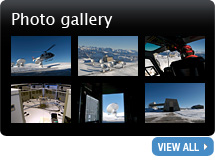Terms of use | Contact us
Copyright © 2009-2023 IRAM. All rights reserved.
YOU ARE ON THE LEGACY WEBSITE OF IRAM. YOU WILL FIND THE CURRENT WEBSITE HERE.
2009 News
December 10, 2009
IRAM scales new heights: At 5000 meters altitude, the institute's equipments capture first fringes at ALMA
IRAM scales new heights: At 5000 meters altitude, the institute's equipments capture first fringes at ALMA
On November 5th 2009, first fringes on the high-altitude site were obtained with the band 7 receivers, measuring the continuum emission of a bright quasar, 3C454.3. The result testifies for the high quality and performances of IRAM receivers, which
exhibit noise figures well below the initial ALMA specifications. With its highly recognized expertise, IRAM is one of the major partners in the construction of ALMA, a giant radio observatory in the Chilean desert...
November 12, 2009
Mayor of Grenoble and Member of Parliament visit IRAM exhibition stand at the Fête de la Science
Mayor of Grenoble and Member of Parliament visit IRAM exhibition stand at the Fête de la Science
The photo shows Grenoble's mayor, Michel Destot, and Geneviève Fioraso, Member of the French Parliament, during their visit of the IRAM exhibition stand at the "Village des Sciences de Grenoble 2009". During 4 days and on the occasion of the French "Fête de la Science", IRAM staff members, astronomers and engineers were explaining IRAM's activities to a general public...
September 21, 2009
30 years of IRAM - Updated conference program now online!
30 years of IRAM - Updated conference program now online!
The updated program is now online. For more information on the program and how to reach the conference center use the button below.
September 10, 2009
Cold interstellar clouds beat the best labs on Earth
Cold interstellar clouds beat the best labs on Earth
Astronomers use an exceptionally cold gas cloud in space to measure the structure of molecules to a precision that cannot be attained in the laboratory. With the IRAM 30-meter telescope they observed...
June 25, 2009
5th IRAM 30m Summer School
5th IRAM 30m Summer School
We will use the IRAM 30m telescope to observe planets, stars, dusty clouds, and whole galaxies, out to the most distant objects known today. On the way, we will discuss the key science questions on the one hand, and calibration and observing techniques on the other hand...
May 14, 2009
IRAM detectors, tiny but great in space
IRAM detectors, tiny but great in space
ESA, the European space agency will soon launch two new scientific satellites for astronomy in a combined mission with its heavy load carrier Ariane 5. Both of them, Planck and Herschel, are equipped with the latest high technology from the Grenoble area. In particular the Herschel Space Observatory (HSO) will embark super-conducting detectors which have been designed and manufactured at the IRAM laboratories.
February 5, 2009
Infant galaxies: small and hyperactive
Infant galaxies: small and hyperactive
When galaxies are born, do their stars form everywhere at once, or only within a small core region? Recent measurements with the Plateau de Bure Interferometer provide the first concrete evidence that star-forming regions in infant galaxies are indeed small - but also hyperactive, producing stars at astonishingly high rates.


